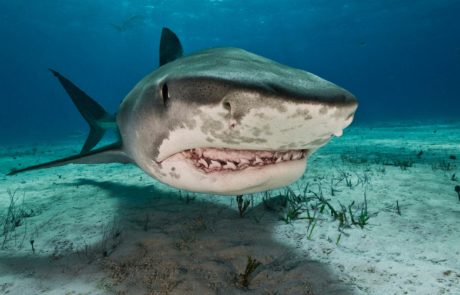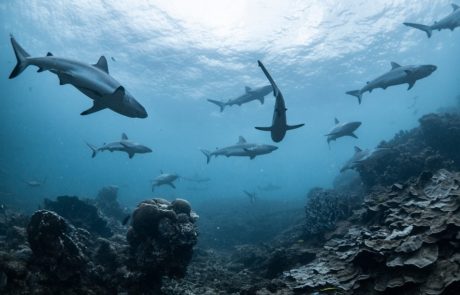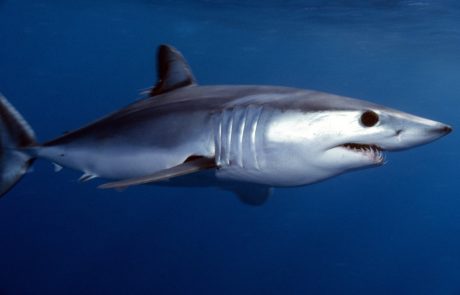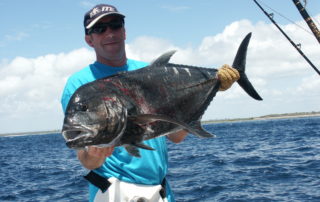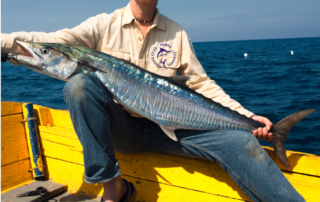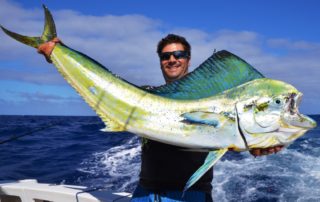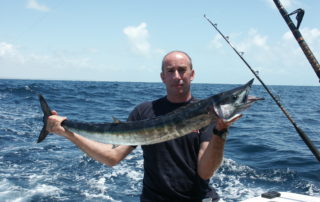Year round quality fishing
We are fortunate in having superb big game game fishing almost all the year, and the Pemba Channel is synonymous with the finest fishing in Kenya. Some of the most exhilarating and challenging deep-sea fishing is available in the blue waters of Shimoni and you have a better chance of catching a Striped Marlin from the Pemba Channel than anywhere else in the world. Traditionally when the Kaskazi (north east monsoon) blows, the billfish arrive in great numbers. There are two very definite seasons, the Yellowfin Tuna season, which runs from August through to the end of October, and the marlin season, which runs from December to mid March.
Which fish can I expect to catch? and when
 Billfish
Billfish
The Pemba Channel provides us with six species of billfish including Black, Blue and Striped Marlin, Sailfish, Broadbill Swordfish and the elusive Shortbill Spearfish, so your chances of catching a grand slam (1 each of any 3 billfish in one day) is very real.
Black Marlin
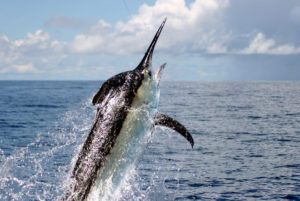 This marlin has tremendous power, size and persistence and is known for its long runs and tail walking. Black Marlin are generally larger than the other marlin and have short, heavy bodies with the fins virtually locked in position. Black Marlin have been caught weighing over 2000lb by commercial fishermen, but the rod and reel record for Black Marlin is 1560lbs. The Black Marlin is noted as a violent feeder at the top of the food chain and feeds on other game fish and small bait fish. Remember, if you do get a strike give the marlin plenty of time to swallow the bait. The largest Black Marlin to be caught from the Club weighed in at 800lb and was caught during the September Tuna season.
This marlin has tremendous power, size and persistence and is known for its long runs and tail walking. Black Marlin are generally larger than the other marlin and have short, heavy bodies with the fins virtually locked in position. Black Marlin have been caught weighing over 2000lb by commercial fishermen, but the rod and reel record for Black Marlin is 1560lbs. The Black Marlin is noted as a violent feeder at the top of the food chain and feeds on other game fish and small bait fish. Remember, if you do get a strike give the marlin plenty of time to swallow the bait. The largest Black Marlin to be caught from the Club weighed in at 800lb and was caught during the September Tuna season.
Season – During August to the end of October, large Blacks can be found amongst the tuna. The prime marlin season runs from mid November to end of March.
 Blue Marlin
Blue Marlin
The Blue Marlin is more of a streamlined version of the Black Marlin. It has a long slender bill extending up to a virtual point on the top of the head where the dorsal fin slants, resulting in a huge speed take off compared to other marlin. The Blue is known for its impressive athletic abilities on the surface, clearing the water time and time again, although they are prone to going deep to conserve their energy. The Blue is known to charge a lure on a number of occasions, so be patient until a good hook up can be achieved. Blue Marlin, of up to 600lb, are not uncommon here. The biggest Blue Marlin caught from the Club weighed in at 724 ½ lbs. This fish was caught in a September, during the tuna season.
Season – During August to end October large Blues can be found amongst the tuna. Blues and Blacks follow and gorge on the shoals of Yellowfin Tuna at this time of the year and are usually fatter than later in the season. The prime marlin season runs from mid November to end of March.
Striped Marlin
Striped Marlin are the most prolific of the marlin and they migrate through the natural corridor between Pemba Island and the mainland. 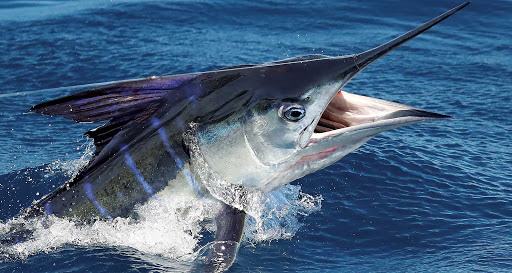 The Striped Marlin is renowned for its speed and acrobatic displays. Compared to a Blue or a Black it is considerably more slender and is the most colourful of all marlin. Just before striking or when the Striped Marlin is annoyed, fourteen iridescent blue lines spark up the marlin’s body. It is one of those must see moments – a Striped Marlin lighting up to strike one of your baits. Striped Marlin are most prolific from November to March, sometimes showing in packs of up to ten, which makes it a good chance of getting a personal best.
The Striped Marlin is renowned for its speed and acrobatic displays. Compared to a Blue or a Black it is considerably more slender and is the most colourful of all marlin. Just before striking or when the Striped Marlin is annoyed, fourteen iridescent blue lines spark up the marlin’s body. It is one of those must see moments – a Striped Marlin lighting up to strike one of your baits. Striped Marlin are most prolific from November to March, sometimes showing in packs of up to ten, which makes it a good chance of getting a personal best.
Season – The prime marlin season runs from mid November to end of March. In March it would seem that the fish are much larger than average. The two biggest Striped Marlin taken from the Club were 254lbs caught on March 6.and 269lbs caught on March 27.
Broadbill
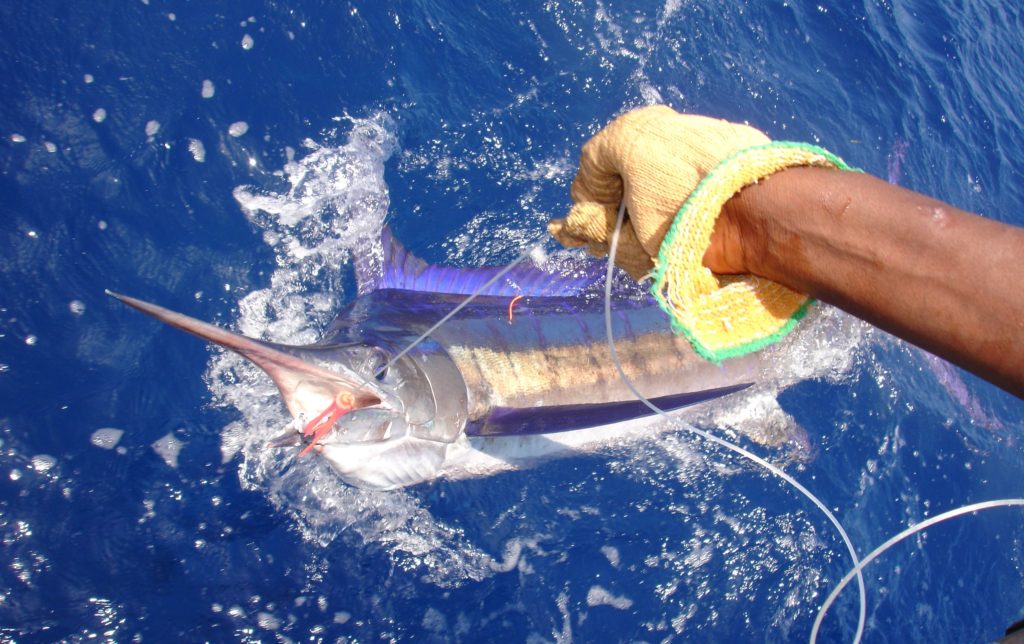 Broadbill (Xiphias gladius) is known as the ‘Gladiator of the Sea’ due to its reputation of being the toughest of all the billfish with a violent mood and the capability of spearing your boat, and is considered to be the toughest of all billfish to catch – the ultimate challenge in big game fishing. It has considerable big blue eyes, and is a ferocious night feeder, a well defined lateral line covering its well built body, large candal keels which enable dynamic speeds and a rigid shark like dorsal fin. They are deep-water predators and are known to go to depths of at least 550m. When hooked it takes deep and rapid dives and with the combination of the soft flesh around the mouth and its sword it makes for a real challenge to catch. Four Broadbill world records have been taken on fly on the Kenyan Coast.
Broadbill (Xiphias gladius) is known as the ‘Gladiator of the Sea’ due to its reputation of being the toughest of all the billfish with a violent mood and the capability of spearing your boat, and is considered to be the toughest of all billfish to catch – the ultimate challenge in big game fishing. It has considerable big blue eyes, and is a ferocious night feeder, a well defined lateral line covering its well built body, large candal keels which enable dynamic speeds and a rigid shark like dorsal fin. They are deep-water predators and are known to go to depths of at least 550m. When hooked it takes deep and rapid dives and with the combination of the soft flesh around the mouth and its sword it makes for a real challenge to catch. Four Broadbill world records have been taken on fly on the Kenyan Coast.
The Pemba Channel is perhaps one of the premier destinations for Broadbill fishing. We troll the channel for Broadbill at night. Special trips to a sea mountain, 55 nautical miles due east of Shimoni can be arranged.
Season – all year but best in October, November and March when the seas are very calm. December before the wind goes round to the north-east can also be an excellent time for Broadbill fishing.
Sailfish
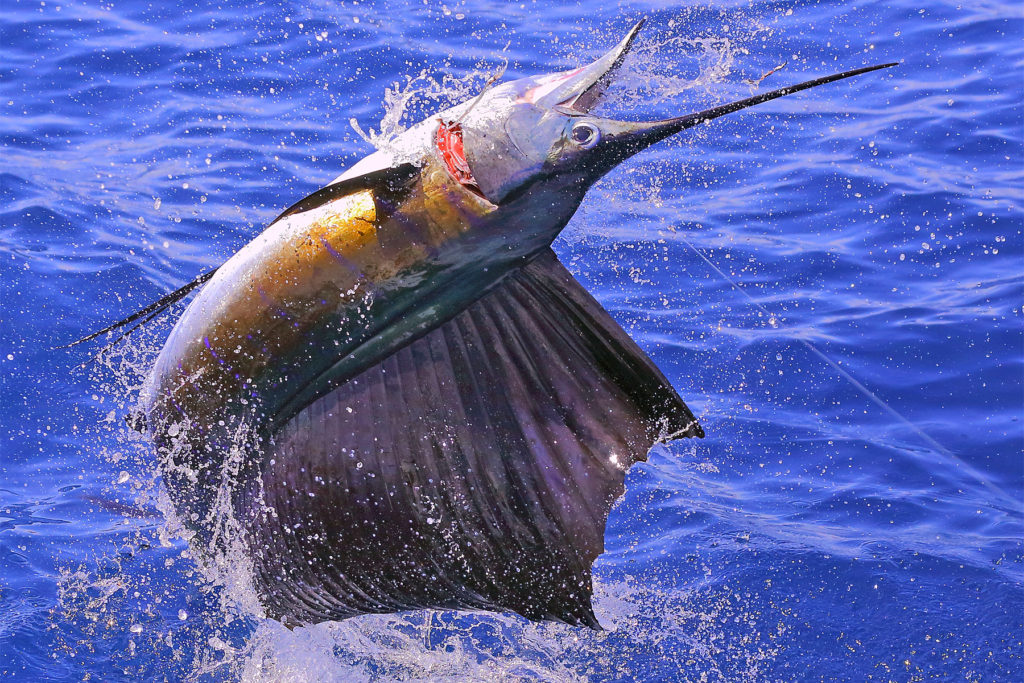 The Sailfish is one of the most strikingly colourful game fish of all – dark blue, black and silver and lights up with white dots and lines of electric blue. It is a very acrobatic fish and will dive quicker than the marlin because of its size and surrounds. Usually found in a depth over 6 fathoms in tropical and subtropical waters near coasts and islands, they feed on crustaceans, octopus, mackerels, tunas, jacks, herring, flying fish and other small fish along the edges of reefs or current eddies. They are a migratory species usually travelling alone or in small groups. Its fighting ability and spectacular aerial acrobatics endear the Sailfish to the saltwater angler, but it tires quickly and is considered a light tackle species. For fly-fishermen who are trying big game fishing on fly for the first time the Sailfish is the perfect species to try your luck.
The Sailfish is one of the most strikingly colourful game fish of all – dark blue, black and silver and lights up with white dots and lines of electric blue. It is a very acrobatic fish and will dive quicker than the marlin because of its size and surrounds. Usually found in a depth over 6 fathoms in tropical and subtropical waters near coasts and islands, they feed on crustaceans, octopus, mackerels, tunas, jacks, herring, flying fish and other small fish along the edges of reefs or current eddies. They are a migratory species usually travelling alone or in small groups. Its fighting ability and spectacular aerial acrobatics endear the Sailfish to the saltwater angler, but it tires quickly and is considered a light tackle species. For fly-fishermen who are trying big game fishing on fly for the first time the Sailfish is the perfect species to try your luck.
Season – are seen and caught throughout the fishing season but most prolific during December and January.
 Shortbill Spearfish
Shortbill Spearfish
This most elusive game fish does exist in the waters of the Pemba Channel, but is infrequently encountered and rarely seen and caught. It is a highly migratory deep-water species feeding at or near the surface on medium-sized fish, including dorado, flying fish and pilot fish, squid and crustaceans. They appear to be available all year in small numbers. Fishing methods are the same as for other billfish but with a maximum weight of 52 kg this is a light tackle contender. The Pemba Channel Fishing Club holds most of the Kenya and All Africa records for the largest fish. Click here to see some of the biggest fish cought here.
Season – mid November to end of March with December being the best month.
Tuna – angling on adrenaline
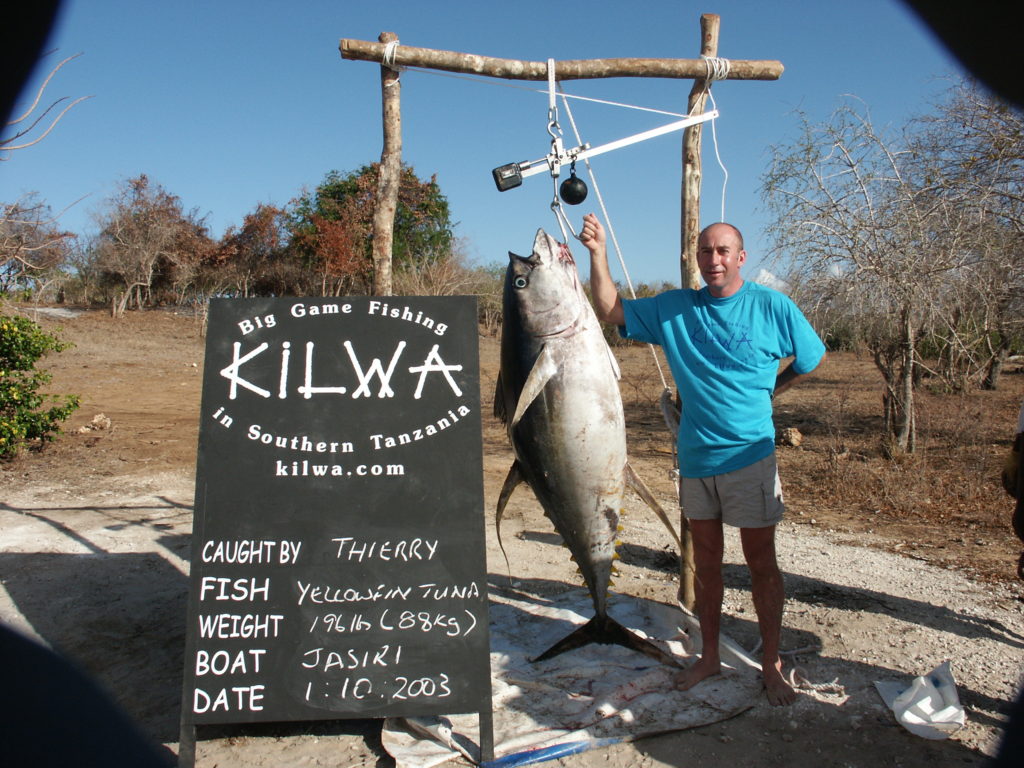 From August we start to see numbers of migrating Yellowfin Tuna, which are, pound for pound, one of the strongest fish that swim and can put up a challenging fight. These swift, sleek marauders of the worlds’ oceans can be picked out from their close relatives by their bright yellow finlets and belly, which sometimes show a series of about 20 vertical rows of whitish spots. Mainly feeding on fish, crustaceans and squids Yellowfin Tuna are not usually caught below 250m in the tropics. These high-speed vagabonds are the quintessence of hydrodynamic perfection in design for speed, and often reach about five feet in length. They make transoceanic journeys on a regular basis. Tuna school primarily by size and 12 – 20lb outfits are ideal for schools of small tuna that run in the season, providing really good sport for the light tackle enthusiast.
From August we start to see numbers of migrating Yellowfin Tuna, which are, pound for pound, one of the strongest fish that swim and can put up a challenging fight. These swift, sleek marauders of the worlds’ oceans can be picked out from their close relatives by their bright yellow finlets and belly, which sometimes show a series of about 20 vertical rows of whitish spots. Mainly feeding on fish, crustaceans and squids Yellowfin Tuna are not usually caught below 250m in the tropics. These high-speed vagabonds are the quintessence of hydrodynamic perfection in design for speed, and often reach about five feet in length. They make transoceanic journeys on a regular basis. Tuna school primarily by size and 12 – 20lb outfits are ideal for schools of small tuna that run in the season, providing really good sport for the light tackle enthusiast.
August to October provides excellent sport for tuna. Multiple hook ups are normal when the ocean can come alive with schools in pursuit of smaller fish creating plenty of excitement with all the rods going at once. Some of the tuna are huge and involve a long, exciting and exhausting fight in the chair. The largest Yellowfin Tuna caught from the Club was 193 lbs.
Season – Typically from August to end October. This is an excellent time for tuna with chances of big Blue and Black Marlin too. Blues and Blacks follow and gorge on the shoals of Yellowfin Tuna at this time of year and are usually fatter than later in the season. The biggest Blue Marlin caught from the Club was in a September at 724lbs and the biggest Black Marlin caught from the Club was also in a September and weighed in at 800lbs. Many lesser game fish, such as Wahoo, Barracuda, Kingfish, Skipjack etc can also provide good sport during these months. The Club holds most of the Kenya and All Africa records for Yellowfin Tuna.
Sharks
Tiger Sharks
Tiger sharks are born at a size of 50 – 75cms with a beautiful silvery pattern of leopard like spots, which change to bars as they grow and fade as they mature. The head is large and blocky with big soulful eyes. Mature Tiger Sharks become very stout. They may be resident in certain areas, but in general they are wanderers. Tag returns indicate movements as great as 3193kms, which is 1984 miles. They tend to stay in deeper water by day and enter shallow waters at night. The largest Tiger Shark taken from the Pemba Channel Fishing Club on 80lb line was caught by novice angler Lt Cdr Graham Watts RN. This weighed in at 924 lbs and is a Kenya and All Africa Record. The largest Tiger Shark landed at the Club was 984lbs taken on 130lb line.
As all sharks are now endangered species we practise 100% tag and release.
Mako Sharks
Mako sharks are torpedo shaped and are the speed kings of the cartilaginous fish and possibly the fastest fish in the ocean – measurements as high as 100kph (60mph) have been reported. When hooked they may jump to a height of several body lengths out of the water. They are able to chase down and consume fast moving pelagics, such as tuna and broadbill.
All sharks are actively and aggressively hunted. In 1990 more than one million sharks were killed worldwide for sport, for meat and for their fins – a sought after delicacy in the Orient. Sharks on the other hand, in the same period, killed six humans.
Bottom Fishing and Reef Fishing
If you want a change or a break from the big sea we are very happy to arrange a day of bottom or reef fishing in a smaller boat with a 25hp engine. Nearby reefs can produce some action packed and very exciting fishing. One would expect to catch some of the lesser game fish.
Lesser Game Fish
Giant Trevally (Caranx Ignobilis)
A member of the Jack and Pompano family, these fish feed at night on crustaceans.
Adults occur singly and inhabit clear lagoon and seaward reefs. Large Trevallies have powerful jaws and sharp conical teeth and can weigh up to 100kg (220lbs). The largest caught at The Pemba Channel Fishing club is a Kenya record at 52.7kgs (115.94lbs)
Kingfish (Scomberomorus commerson)
Also known as Narrow-barred, King or Spanish Mackerel, the Kingfish is a highly rated gamefish that sounds often, runs hard and fast, and occasionally leaps. Fishing methods include surface or deep-trolling with squid, mullet, sauries, flyingfish, garfish, and strip baits, as well as with artificial trolling lures. Live-bait fishing near reefs with these and other natural baits is also productive. The best fishing is at dawn or dusk and at high or low slack tide. Kingfish feed mainly on small pelagic schooling fish like anchovies and sardines, as well as on flyingfish, squid, and shrimp. The record from The Pemba CHannel Fishing Club is a Kenya record at 15.65kg (34.43lbs).
Dorado or Mahi mahi (Coryphaena hippurus)
Common name of Dolphin fish, found in open waters but also near the coast. They feed on almost all forms of fish and zooplankton, crustaceans and squid. They love to congregate under any floating object although larger dorado tend to be ocean roamers. Dorado run hard and leap often and, sometimes tail-walk rather spectacularly across the surface. They can grow up to 45kg (99lbs), but the largest caught at The Pemba Channel Fishing Club weighed 15.5kg (34.1lbs), which was a Kenya and All Africa record
Wahoo (Acanthocybium solandri)
A member of the mackerel family with very sharp teeth, these fish feed on fish and squids. They are located over or along humps, ledges, seamounts, and other structures that cause currents to well up and provide good feeding opportunities, as well as along current edges and around floating objects.
Wahoo can grow up to 65kg (143lbs), the largest caught at The Pemba Channel Fishing Club weighed 27.2kg (59.84lbs) and is a Kenya ladies record.
Barracuda (Sphyraena barracuda)
Barracuda (Sphyraena barracuda)
The species found in the Indo-Pacific on the east coast of Africa is the Great Barracuda. Light- to medium-action spinning, baitcasting, or flycasting tackle provides the best sport, but many anglers troll for these fish, too. They are found predominantly at or near the surface and feed on fish, squid and octopus and sometimes on shrimps. They often strike savagely, and they frequently jump out of the water when hooked. The largest caught at The Pemba Channel Fishing Club is a Kenya ladies record weighing 26.5kg (58.3lbs).


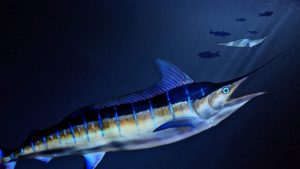 Billfish
Billfish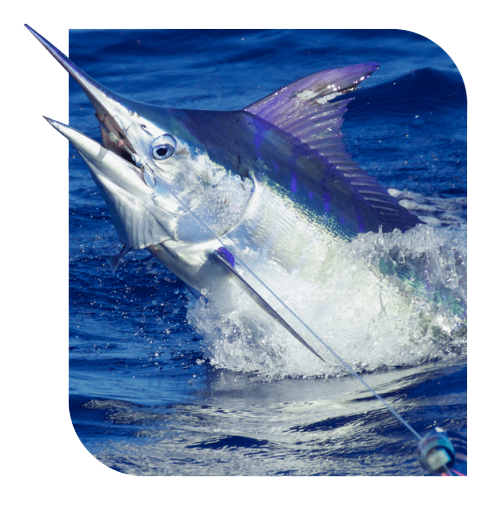 Blue Marlin
Blue Marlin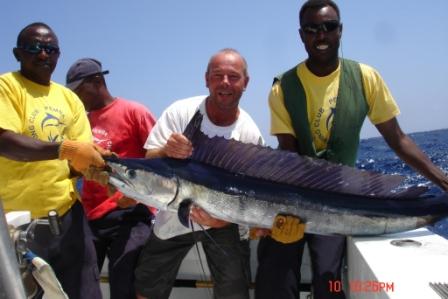 Shortbill Spearfish
Shortbill Spearfish